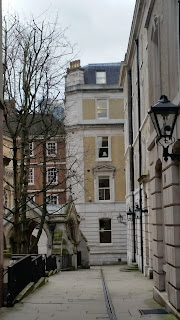I followed the pedestrian street lined
with 19th Century style lamps attached to the buildings’ walls. At
the bottom was what at first appeared to be a small chapel. As I walked around
the outside, it became a large church on the edge of a Georgian paved square. From
here was an arch leading to another square. And from there, another arch. This
one took me to a narrow cobbled road with a few parked cars, but otherwise no
traffic and another square opposite.
When I looked right, the road lead back
to Fleet Street. To the left, it lead down, through another arch, to the river.
There was a constant and thin stream of pedestrians walking through with pupose.
Clearly a popular route.
I followed the road down. Off to one side there was
another arch leading to a square with a manicured garden in the middle. In it
was a series of benches. A peaceful haven in the middle of the city. I used to
work just up the road from here. How had I never found it before?
Back on the private road, I continued
downhill. Through the final arch I found myself on Victoria Embankment. In one
direction I could see The London Eye dwarfing Westminster Palace which, because
of the way the river curved, looked to be next to it instead of opposite. In
the other direction was The Shard framed by the trees. It’s glass walls glinted
in the sunlight that had appeared after the rain.
The Embankment was even more clogged up
with traffic than Fleet Street. I turned round and returned to the quiet of
Middle Temple Lane.













